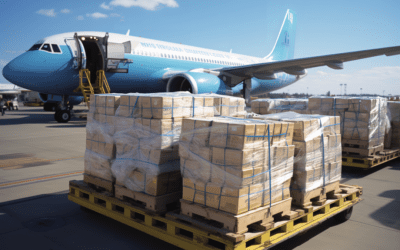In previous years, many companies moved production to countries outside the United States, engaging in reshoring operations, to benefit from lower costs and faster operation time. However, complications with output during the pandemic brought forth many issues in reshoring operations and unveiled gaps and inefficiencies in supply chains
Article Overview
Companies continue to grapple with the impacts and face lingering effects of the pandemic, actively seeking ways to mitigate supply chain disruptions and explore alternative sourcing options.
As the virus subsides and complications persist across seas, many companies choose to return operations to a centrally located spot near their headquarters. This is where the reshoring trend gains significance. Reshoring involves companies returning the production and manufacturing of goods to the company’s country, promoting local economic growth, and providing greater control over the supply chain.
Hurdles of Reshoring
The growing demand for reshoring presents challenges for companies intending to relocate to their original country for operations. Companies must carefully consider the costs and logistical complexities of a big move like this.
While specific challenges vary depending on the business and industry, companies must assess the feasibility of bringing production closer to home base. In doing so, companies should prioritize sustained advantages over immediate profits.
Long-Term Advantages vs. Immediate Profits
Establishing a long-term goal for reshoring can provide valuable benefits for a company. By adopting a long-term perspective, organizations can gain a broader outlook and thoroughly evaluate the advantages and disadvantages of reshoring.
This perspective opens discussions and addresses the company’s pain points, optimizing manufacturing and production operations and identifying opportunities for efficiencies within the company.
Identifying long-term advantages and suitability of reshoring can benefit companies, but even then, they must overcome various hurdles throughout the process. Companies should consider the following obstacles when undertaking reshoring initiatives:
- Infrastructure Constraints
As the reshoring trend gains momentum, many companies must prepare to accommodate the necessary resources to relocate. The need for more available and suitable infrastructure raises concerns and imposes constraints on expanding production capacity.
Even if companies consider reshoring a viable option, constructing large-scale infrastructures is time-consuming.
- Investments
Reshoring often involves a significant investment from the company. Relocating manufacturing operations alone draws expenses, and additional costs for upgraded equipment and technology can also be costly. Relocating may result in financial strains and restrict a company’s capacity to expand its other production capabilities.
Investments companies must consider when reshoring are employee wages. Companies must realign their priorities and develop a strategy to employ higher-wage workers while ensuring profitability. Careful planning and innovative approaches can balance labor costs, productivity, and finances.
- Regulatory Compliance
Operating across borders creates various complications, and regulatory compliance is vital. However, it is equally crucial to consider regulatory requirements when engaging in nearshoring. Different regions have varying regulations and standards to meet when reshoring production.
Ensuring regulations are compliant, obtaining permits, and securing necessary certifications can present additional challenges and constraints. Therefore, careful attention and proactive measures are essential to navigate the regulatory landscape and maintain compliance.
- Market Demand Fluctuations
Uncertain market conditions can often influence reshoring. When a company assumes that aligning market demands and production in closer proximity will enhance effectiveness, there is a risk of compromising profitability. Carefully assessing market trends and considering the impact on profitability is crucial before committing to new initiatives.

Reshoring Rewards
When companies take the time to consider the advantages of reshoring, they open up opportunities to boost their efficiency and increase their profits in the long run. Reshoring manufacturing operations offer significant savings on transportation costs, which is almost every company’s most significant expense.
- Reduced Risks of Disruption
Manufacturing products overseas, thousands of miles away from the business, extra time is spent transporting packages to the facility. However, producing localized goods can create more efficiency, resulting in timely manufacturing and shipping.
The United States has also contributed various technologies and inventions to accelerate manufacturing processes and mitigate potential disruptions. Leveraging technological advancements creates the opportunity to revolutionize the supply chain process and enhance the efficiency of its workforce. Harnessing innovations can increase optimization in the supply chain and empower the workforce to improve operations.
- Improved Quality
When manufacturing overseas, there is limited control over production quality, flexibility, and responsiveness. Nearshoring allows companies to observe and assess products before they are shipped out. Proximity allows for greater visibility and ensures better control over product quality in the manufacturing process.
Reshoring gives companies direct control over production processes and enables them to enhance quality and ensure goods are up to standards. Ultimately, proximity leads to improved oversight and the ability to make adjustments timely to enhance overall production outcomes.
- Increased Flexibility and Responsiveness
Demands for products provide companies with the ability to cultivate flexibility within their operations, which increases responsiveness. Flexibility within production time enables companies to make necessary adjustments to their process. Manufacturers can effectively tackle challenges and maintain a competitive edge by being responsive to market dynamics.
Considering Other Locations
The global manufacturing and supply chains were undeniably impacted by the COVID-19 pandemic, leading to ongoing resource shortages. Consequently, various countries, including the U.S., are reevaluating their strategies and opting to bring manufacturing back to local regions.
Reshoring is commonly associated with companies returning to their country. However, with the increasing number of companies relocating to the U.S., there is a risk they could face higher expenses and costlier products. While product prices may increase, a recent survey revealed that Americans are willing to pay a premium of 15% to 20% for products made in the States, highlighting a stronger preference for domestically produced goods.
Before the pandemic, it made economic sense for companies to outsource production to countries with lower product and labor costs. Factors such as rising labor rates, shifting geopolitical climates, and growing environmental concerns have prompted many companies to reconsider their global locations. Exploring alternative low-cost countries while reshoring specific productions to America has emerged as a leading strategy for many companies based in the U.S. and Western European companies.
Companies can determine the most effective approach to optimize their operations by carefully assessing various location options.
Final Thoughts
The impact of the pandemic on global manufacturing and supply chains causes many companies to reconsider their production strategies. Due to nationwide effects, reshoring has gained momentum. Reshoring allows companies to regain control over their supply chains, enhance quality, and increase responsiveness to market demands.
With challenges such as infrastructure limitations and significant investment costs, understanding the long-term benefits of reshoring, including reduced risks of disruption and improved efficiency, makes it a compelling choice.
As companies navigate the complexities of reshoring, strategic planning, and adaptability will be very important in deciding whether the company will benefit from or face disadvantages.






